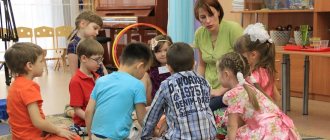Development of imagination in preschool children. It is impossible to imagine a child without imagination. The world of children differs significantly from that of adults because children are capable of inventing and thinking outside the box. The ability to imagine helps develop creative abilities, find ways out of difficult situations, and it is easier to adapt in real life if you direct your imagination in the right direction.
Features of the development of creative imagination in a preschool child
The baby takes his first steps towards the ability to use his imagination at the age of three. Play becomes part of the child, wherever he is: at home, on a walk, visiting, on a trip. During this period, the child begins to understand that one and the same object can play the role of several, if you use your imagination. Three- and four-year-old children begin to tell fairy tales - this awakens their previously dormant imagination. But they don't know how to plan. It is difficult to find out from such a child what he is going to draw if the child took pencils and paper. With the help of imagination, the drawing, of course, will be born, but the image of the future “picture” will be built in the process.
Until the age of five, preschool children still do not know how to direct their imagination, but at five or six years old they are already good inventors who can consciously decide what they want to play, what they need to draw, what craft they want to make. Once the goal is set, the work begins. Often, in play, children try to embody the experience they have gained, their impressions of watching a cartoon or a play, or some life scene.
Often children create their own special world if something in the real world does not suit them: difficult relationships with peers or adults, including parents; phobias that the child tries to fight in a self-invented way; problems that are easier to solve in a fantasy world.
In any case, the development of imagination is very important for a child. This is one of the levers with which a little person learns to interact with the world.
Where to start for parents
To develop a little person’s imagination, you don’t need to spend a lot of time or money on additional classes with teachers. What can parents do?
- Tell interesting stories . Remember that the connection between generations was established through the transfer of information from older, experienced family members to younger ones. It is not necessary to use colorful, illustrated books or special manuals.
- It will be interesting for your child to hear a story from their parents on the way to kindergarten, before bed, or on a walk. Cautionary stories may be short, but they must be interesting and attract attention.
- Engage in creative activities . Together, draw, sculpt, make crafts from natural materials, and build from construction kit parts. There are many ideas on how to lure a little fidget. Give your child freedom to be creative. Let him draw with his fingers, cut out figures with children's scissors and paste them into an album, and make toys for the puppet theater. Tactile activities develop fine motor skills, and as a result of work, the child will be able to show creativity. Be sure to praise your child when he finishes his work. Hang the picture, even if it is drawn sloppily, in a prominent place or carefully place it together with other crafts.
- Use available tools . It is not necessary to use expensive paints, kinetic sand, or special creativity kits. Simple things that are always at hand also contribute to the development of children's imagination. For example, in a sandbox you can build a city out of sand, and make funny little animals out of cones and acorns.
- Control your viewing of cartoons . On gadget screens, children are offered ready-made solutions, and they do not need to think out, fantasize, or create anything. The baby needs to be provided with his own, personal space where he can realize his own fantasies. Unfortunately, parents often raise a child who is a consumer, not a creator.
Of course, it’s easier for mom to give the baby a tablet and calmly go about her business. But spend just an hour playing with your baby: look through a book together, draw, make figures from plasticine. It is important for a small child that his parents be nearby, offer activities, praise, and encouragement.
Types of imagination
Experts distinguish several types of imagination.
Creative
Human consciousness allows you to compose incredible images, without relying on knowledge and experience. Such imagination, with its further development, can even become the basis for a person’s future profession related to writing.
Recreating
This type of imagination is based on existing knowledge; images that the child became acquainted with in classes, in communication with relatives and friends appear from memory and are developed.
Wild fantasy
Uncontrolled imagination, where reality and fantasy replace each other. The child constantly thinks about something and declares that all this actually happened.
Chance to become unique
In fact, from birth, every baby is initially gifted with the ability to fantasize, create, and imagine.
But over time, “good” fathers and mothers decide that their child does not need all this. Therefore, they begin to intensively develop logic and analytics in them, and teach them “useful and necessary for our harsh life.” But this is fundamentally wrong. Undoubtedly, a person who has a lot of useful knowledge and skills in life, no matter how harsh it is, will not be lost. But life will not be good either.
Therefore, by developing our baby’s imagination, feeding his fantasy, we give him an amazing chance to become a unique person.
Methods and techniques for developing imagination in preschool children
Since healthy imagination is important for the harmonious development of a child, adults should help develop this imagination correctly.
There are several effective techniques. They are based on the development of the child’s creative abilities, as well as his mental activity.
This:
- Applied activities,
- Literature classes,
- Didactic games,
- Development of horizons,
- Development of tactile abilities,
- Art, music, dance classes.
Applied activities are one of the methods not only to awaken a child’s imagination, but also to direct him in the right direction. So, drawing or modeling classes will help teach your child to come up with and implement an idea. Construction will make it possible to create something fantasy, but this object can already be touched, it can become the object of games. Let the child come up with things that do not exist in the real world, but this is much more interesting. A fictional thing may have characteristics that the author himself gives it.
A good option to develop imagination is fairy tales that the child himself composes. An adult just needs to help, give a start to imagination. Let this be a simple story, the very beginning. And only then the child must figure out what will happen to the characters next, what adventures await them. And if a child comes up with a fairy tale and draws at the same time, clearly showing the plot, even better.
Didactic games play a great role in the development of imagination. An experienced teacher can interest a child by inviting him to study and play at the same time.
So, you can use the following techniques.
What is the difference between fantasy and imagination?
First of all, let's understand the very concepts of fantasy and imagination. In the understanding of most people, these terms are identical, but in fact they are fundamentally different things.
Fantasy is a certain imagined situation that has nothing to do with reality. For example, flying unicorns or the tooth fairy are nothing more than children's fantasies.
But imagination is the ability to consciously form certain images of reality and manage them. What is important is that these images correspond to reality and do not contradict it in any way. For example, a child may imagine how he answers brilliantly in class or solves a difficult problem, becomes the owner of a huge house or gets a dog. Thus, imagination is the idea of what may well happen.
Fantasy is the idea of something that cannot happen in reality. For clarity, we present a comparative table of fantasy and imagination.
| Fantasy | Imagination |
| A situation far from reality | A situation based on reality that can develop |
| It remains a fiction | Could come true |
Obviously, from a practical point of view, imagination is more important. This is the child’s creativity, his creativity and ability to simulate specific situations.
The most important thing is to improve a child’s creative imagination, but it is closely intertwined with fantasy. Therefore, it is necessary to develop both of these directions. What will this do for your child?
- he solves non-standard problems more easily and learns to find the optimal solution in unpredictable situations;
- he adapts to life and understands his place in it;
- he learns to think, make decisions and see their consequences.
Although fantasies are groundless inventions, they are a source of inspiration and joy for a child. There is no need to greatly limit him in his fantasies. The main thing is that fictional images do not separate him from real life, but, on the contrary, enrich it.
Developing imagination through non-traditional drawing
Unconventional drawing methods are unusual, interesting and useful. The child learns to see the miraculous in the most ordinary things. So, he learns that, it turns out, you can draw, for example, with your palms, a comb and a sponge, and not with a brush, with biscuit cream, and not just with paints. This awakens the imagination, the child has a desire to try new and unknown things.
Here are the simplest ways to draw unconventionally:
- Drawing with a candle.
- Drawing with splashes through a straw.
- Drawing with stamps made from bottle caps, sponges, chewed paper.
- Finger painting.
- Isothread: the thread is dipped into the paint, pressed against the paper, and the resulting print can be expanded into a real design.
- Drawing with a comb.
- Drawing with a cotton swab.
- Children of any development will enjoy drawing this way. Moreover, some methods help in the prevention of certain diseases, as well as in the correction of speech, breathing, and vision.
Development of imagination by means of construction
There are many construction sets on sale that both children and adults enjoy playing with. Of course, there is no need to set complex design tasks for the child. But construction kits with proposed assembly schemes can be the start of an interesting hobby for a child. And if an adult gets involved in the design, then the design itself can turn into a game.
Design helps:
- develop spatial imagination,
- gain knowledge about shape, size, the first rudiments of knowledge about geometry,
- develop fine motor skills, which is useful for the development of thinking,
- develop independence, perseverance,
- develop imagination.
It will be useful for preschoolers to play with cubes, which will allow them to get a first idea of shape, color, size; mosaic, which teaches you to pay attention to little things; block constructors that create three-dimensional objects for games; Lego, with the help of which children become acquainted with 3D modeling skills.
Ability to make non-standard decisions
In the end, it doesn’t matter what profession he chooses or what life situations he finds himself in. A developed imagination will allow you to make non-standard decisions. And also to highlight nuances that are unnoticed by others, to look at any problem as if in 3-D format.
Thus, dear parents of a preschooler, right now you have a choice: do everything according to the rules.
- Teach to read, write, stand up for yourself, fight back, become independent, etc.
- Take a different path and raise an extraordinary, confident, and thinking person.
So, remember that “without imagination, there is no consideration” (folk wisdom).
Imagination disorders and their causes
Children may suffer from a lack of imagination or, on the contrary, their imagination becomes uncontrollable.
Imagination deficits are usually experienced by children with speech impairments, because speech and thinking and imagination are interconnected. With speech pathology, the child thinks primitively, he is not able to create a new image, he cannot invent, compose, and also carry out tasks of an adult where he needs to use his imagination. These children usually have difficulty remembering terms, assimilating the acquired knowledge, and do not understand symbols.
Children who have low self-esteem may also have a deficit of imagination. They are afraid of doing something wrong, they are absolutely deprived of independence, which suppresses imagination.
In this case, teachers need to creatively overcome the child’s inhibition step by step, offering to develop abilities through play, the basis of which will be a situation familiar to the child. A good way out of this situation would be the theater. You also need to focus on cognitive activities to broaden the child’s horizons. Emphasis on emotions will play a big role. What impressed you will leave a mark on your soul, and you will want to learn more about it.
Violent fantasy, which can manifest itself in aggression, lies, fears, and the replacement of the real world with a fantasy world, can also interfere with the normal productive development of the imagination.
The reasons for this inadequate imagination may be the child’s internal fears, problems he has with family and peers, inability to get along with the outside world, as well as other psychological problems.
In this case, it is advisable to contact psychologists who will help create an individual program to eliminate the pathology.
What influences the development of a child’s imagination
In order for the development of a child’s imagination to proceed correctly, it is necessary to create a comfortable atmosphere in which the child will learn to fantasize with pleasure and benefit, but will not cross the dangerous line between reality and the illusory world.
- Develop speech, since thought processes are associated with speech functions.
- Pay attention to the development of the child's fine motor skills. The more actively a child works with his hands, the better he speaks and thinks.
- Eliminate loneliness, which, in turn, will eliminate the need for the child to create imaginary friends.
- It is important to increase a child’s self-esteem, not by comparing him with other peers, but by comparing him only with himself, based on his achievements and actions.
- Trusting relationships with parents play a big role. If a child is not afraid of punishment, then he will not have to lie. But you can encourage creative writing - fairy tales, stories, drawings, crafts.
- There should be a lot of creativity in a child's life. These activities stimulate the imagination.
Based on the above, we can draw the following conclusions:
- The development of imagination is an integral process in the development of an individual personality. Responsibility for the development of the child’s imagination lies on the shoulders of the parents, who lay down fundamental knowledge about ideas (the child’s actions, and soon speech).
- Imagination is closely related to cognitive processes (attention, perception, thinking).
- Imagination activates the creative side of the personality.
- The child’s imagination is based on the child’s immediate life activity.
- The intellectual development of a child directly depends on imagination.







